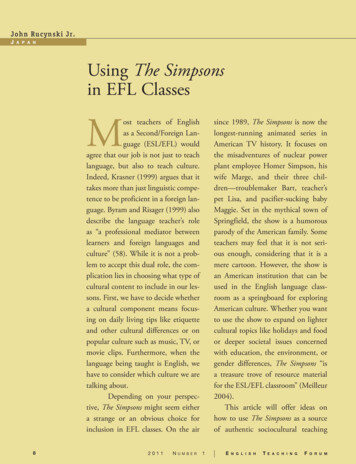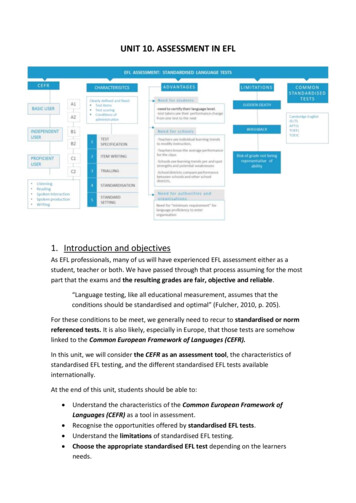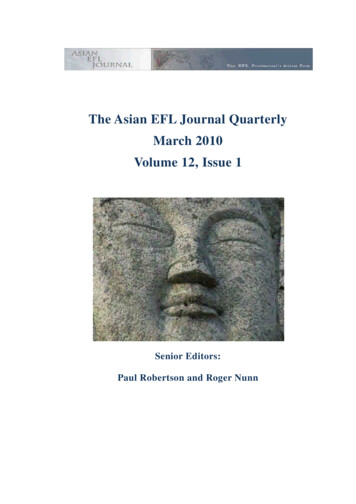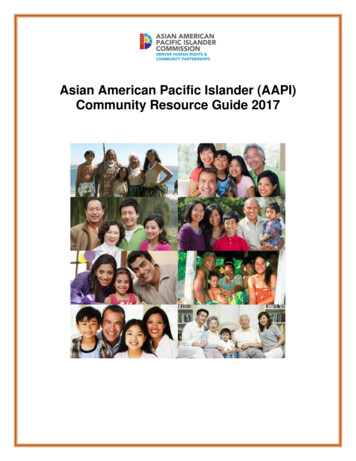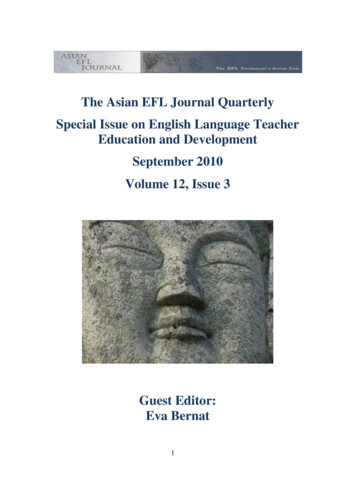
Transcription
The Asian EFL Journal QuarterlySpecial Issue on English Language TeacherEducation and DevelopmentSeptember 2010Volume 12, Issue 3Guest Editor:Eva Bernat1
Published by the Asian EFL Journal PressAsian EFL Journal PressA Division of Time Taylor International LtdTime Taylor CollegeDaen dongBusan, Koreahttp://www.asian-efl-journal.com Asian EFL Journal Press 2010This book is in copyright. Subject to statutory exceptionno reproduction of any part may take place withoutthe written permission of the Asian EFL Journal Press.No unauthorized photocopyingAll rights reserved. No part of this book may be reproduced, storedin a retrieval system or transmitted in any form or by any means,electronic, mechanical, photocopying or otherwise, without the priorwritten permission of the Asian EFL Journal.editor@asian-efl-journal.comPublisher: Dr. Paul RobertsonGuest Editor: Dr. Eva BernatJournal Production Editors: Dr. Aradhna Malik and Allison SmithISSN 1738-14602
Table of Contents:Foreword by Eva Bernat . . .4-71.8-392.3.4.5.6.7.8.Caroline Brandt. .- Competition and Collaboration in Initial Teacher Education in TESOL:A Case of a Classic Double BindHoa Thi Mai Nguyen and Richard B. Baldauf Jr. .- Effective Peer Mentoring for EFL Pre-service Teachers‟InstructionalPracticum PracticeOlcay Sert. .- A Proposal for a CA-Integrated English Language TeacherEducation Program in TurkeyFeroze Kasi. .- Collaborative Action Research: An Alternative Model for EFL TeacherProfessional Development in PakistanStan Pederson. .- Using Perplexing Survey Questions With Repeated Pair Discussions toEnhance the Depth of Expression of Beliefs: The Case of Pre-serviceJapanese EFL TeachersGrace Ika Yuwono and Lesley Harbon. .- English Teacher Professionalism and Professional Development:Some Common Issues in IndonesiaRose Senior. .- A Socio-pedagogic Theory of Classroom Practice to Support LanguageTeacher Development in AsiaDavid Litz. .- Distance Doctor in Education Degrees: Past Experiences,Current Developments and Future Possibilities in ok Reviews1. Second Language IdentitiesDavid BlockReviewed by Buripakdi Adcharawan. .2. Academic DiscourseKen HylandReviewed by Jim Bame. .3. Classroom Interactions as Cross-Cultural Encounters:Native Speakers in EFL LessonsJasmine C. M. Luk and Angel M. Y. LinReviewed by Handoyo Puji Widodo. .4. Classroom ManagementThomas S. C. Farrell (Ed.)Reviewed by Marilyn N. Lewis. .204-205Asian EFL Journal editorial information and guidelines . .206-2153195-197198-200201-203
ForewordDear Readers,Welcome to the Special Issue on English Language Teacher Education andDevelopment: Issues and Perspectives in Asia. This volume brings together wideranging theoretical and empirical contributions that explore a number of keydimensions of EFL teacher education and professional development. The paperscontained in this volume come from colleagues working in diverse corners of theglobe, bringing rich and illuminating perspectives from Asia, The Middle East,Australia, and Europe.First of all, I would like to thank the authors for the many insights shared, andcongratulate them on making the final cut! We have received an overwhelmingresponse to our call for papers, evidencing an enormous interest and currency ofissues pertaining to the theme of this Special Issue. I would also like to thank theauthors for their patience in what has been a rather lengthy editorial processconsisting of two rounds of blind reviews. In the end, I hope we have provided youwith a rich tapestry of methodologically and ideologically diverse yet complementarystudies.In the first paper, Caroline Brandt raises a number of critical issues that emerged fromher in depth study involving CELTA teacher trainees from 9 different countries. Theauthor argues that, inter alia, the competitive nature of the CELTA course resultingfrom its grading system does not facilitate a ‗learning community‘ culture in theclassroom, and that there is a need to deemphasize competition and encouragecollaboration. This is indeed an important issue, as principles of andragogy, or adulteducation theory, have for a long time now emphasized collaboration overcompetition as more desirable and effective in the adult learning context.4
A study into effective peer mentoring in a pre-service EFL practicum is reported inthe second paper by Hoa Thi Mai Nguyen and Richard B. Baldauf Jr. The authorspresent a quasi-experimental design study that investigated the effects of peermentoring on participants‘ professional practice in terms of the instructional domain.The results were then compared to a group of pre-service teachers who did notparticipate in the peer mentoring experiences. Key stakeholders such as school seniorteacher mentors, university supervisors and practicing teachers‘ self-assessmentsindicated that the participants in the peer mentoring program made significantimprovements in their scores for instructional practice compared to their counterparts.Peer mentoring provides an enriching experience that can be applied across teachereducation contexts.Olcay Sert looks at a different aspect of EFL teacher training in the third paper. Byreviewing recent studies in Conversational Analysis, Critical Reflective Practice,Teacher Language Awareness and language teacher education in general, the authorcalls for a more effective language teacher education programs and presents anapplicable framework that aims to solve current problems in English language teachereducation, particularly in the Turkish context. This innovative framework suggestspractical pedagogical implications that could easily be applied to other contextswhere teachers could benefit from such an approach.The fourth paper by Feroze Kasi proposes collaborative action research as analternative model for EFL teachers‘ professional development. Kasi finds inadequacywith the current ‗knowledge transmission‘ model in teacher education in Pakistan andsuggests that a framework based on conceptual principles of Vygotskian socioculturaltheory and Wenger‘s (1999) community of practice theory provides a more suitablealternative for English language teacher education. The author proposes that once anaction research cycle of planning, action, observation and reflection is initiated, it hasthe potential to continue to re-occur and contribute to the professional development ofboth pre-service and in-service teachers on a regular basis, resulting in more effectiveteaching practice.5
The topic of ‗teacher beliefs‘ has been of interest to researchers for over two decadesnow. Stan Pederson‘s well theorized in-depth study describes a technique featuringperplexing questions combined with paired conversations and written follow-upresponses used to elicit teaching beliefs among pre-service teachers. The study aimedto help teachers to share and justify their beliefs as part of a larger process ofintegrating theory, beliefs and practice. Pederson found this procedure to be effectivein generating more explicit beliefs including reasons, conditions and/or contexts, andcould easily comprise an awareness-raising component in teacher educationprograms.EFL teacher professionalism and professional development in Indonesia is the focuson the next paper by Grace Ika Yuwono and Lesley Harbon. Based on qualitative dataobtained from 46 teachers, the authors present a number of findings that they argueare unique to the Indonesian context, and often different from what is constructed bycommon literature on teacher professionalism. They focus on two areas in particular:teachers‘ motives for entering the profession and teaching rewards, and examine howthese impact on one‘s professional development.Rose Senior‘s paper describes a two-phase study conducted in Australia that led tothe development of a teacher-generated socio-pedagogic theory of classroom practice.The theory that emerged from the research proposes that effective classroom teachinginvolves not only teaching content in a proficient manner, but also developing arelationship with the class where teaching and learning become a collective,collaborative endeavour that lifts the performance of individuals. Rose argues that thenotion of class-centred teaching may be a useful means of encouraging locally-trainedlanguage teachers in the Asian region to reflect upon their current teaching and classmanagement practices and to modify them in ways that are congruent with theirpersonal belief systems and appropriate for their local educational contexts.6
Finally, David Litz explores the current thinking surrounding the emergence,evolution, trends, problems and future possibilities in modern distance learning,particularly EdD programs. He argues that the growth of distance EdD programs isclosely aligned to the increased popularity, appeal and accessibility of distance orblended higher education programs, yet points out that these have not been devoid ofproblems such as the quality of instruction, course design and delivery, andtechnology. The author provides us with several recommendations for future researchin this area, and reminds readers that future distance/blended EdD programs need tocontinue to focus on developing comprehensive, inclusive and thoughtful distancelearning models that facilitate true virtual teaching and learning communities.It is my hope that readers of this issue will be enriched by the scope and depth ofthese contributions.With best wishes,Eva BernatGuest Editor7
Competition and Collaboration in Initial Teacher Education inTESOL: A Case of a Classic Double BindCaroline BrandtPetroleum Institute, United Arab EmiratesBio Data:Caroline Brandt is an Assistant Professor at the Petroleum Institute, Abu Dhabi,United Arab Emirates, where she teaches academic communication and researchskills to female engineering students taking B.Sc. degrees. She has 28 years ofexperience in the field of adult second language teaching and has held a number ofsenior positions in higher education institutions in 6 countries, including Hong Kong,the Sultanate of Brunei, the United Arab Emirates and New Zealand. She specializesin professional development and academic communication. Her publications includetwo books that reflect these areas of interest: Read, research and write: Academicskills for ESL students in higher education, UK: SAGE Publications Ltd, 2009; andSuccess on your certificate course in English Language Teaching: A guide tobecoming a teacher in ELT/TESOL, UK: SAGE Publications Ltd, 2006.AbstractRecent research examined participant learning on internationally-available initialTESOL training courses leading to award of the Cambridge Certificate in EnglishLanguage Teaching to Adults (CELTA). Qualitative methods, used to collect andanalyze interview and questionnaire data from 95 participants in nine countries, led tothe identification of critical issues related to participant learning. Several indicated aconflict between assessment and group work in Teaching Practice. Teaching Practiceis carried out in groups and performance is assessed according to criteria whichinclude participants‘ ability to work constructively with colleagues. Upon completionof the course, successful participants may pass or pass with distinction (‗A‘ or ‗B‘).However, these grades are awarded to only 25% of participants, a situation whichleads to competitiveness as participants vie for a limited number of distinctions. Thiscompetitiveness interfered in particular with the group work required for successfulcompletion of Teaching Practice, resulting in a classic double bind. The implicationsof this situation are examined, and the need to deemphasize competition andencourage a ―learning community‖ culture is identified, predicated on the eliminationof the award of distinctions on CELTA courses.Keywords: CELTA, ELT training, teacher training, double bind, collaboration,assessment, group work, competition8
IntroductionEstimates based on published data indicate that well over 16,000 peopleworldwide annually enter the profession of Teaching English to Speakers of OtherLanguages (TESOL), also known as English Language Teaching, or ELT, by takingone of several internationally-recognized initial teacher training courses for TESOL.Such courses aim to produce teachers who are skilled in teaching English language toadults from different language backgrounds and for whom English is a SecondLanguage (ESL). Examples of courses currently available include the CambridgeCertificate in English Language Teaching to Adults, or CELTA, which accounts forthe initial training of over 12, 000 annually people (Cambridge ESOL Examinations,CELTA Trainee FAQs, 2009); the Trinity College London Certificate in TESOL (the‗CertTESOL‘), taken by over 4, 000 people annually through 120 centres in the UKand worldwide (Pugsley, 2005), and the US-based School for International Training‘sTeaching English to Speakers of Other Languages Certificate (the ‗SIT TESOLCertificate‘), as well as many other comparable courses. These courses arecharacterized by being centrally-planned but locally-implemented; that is, theircurricula, including their assessment criteria and standards, are specified by thecentral organization or headquarters (the University of Cambridge ESOLExaminations, in the case of the CELTA, for example), but the courses are runinternationally by local centres (often languages schools), and monitored, orvalidated, through an inspection process carried out by representatives of the centralorganization.While much research has been carried out into the induction of teachers intothe domestic contexts of primary and secondary school teaching in many countries(see for example, Elliott, 1978 & 1992; Bullough, Knowles & Crow, 1991; Tickle,1994; McNally, Cope, Inglis & Stronach, 1997; Caires & Almeida, 2005), there hasbeen far less investigation into the initial training of those wishing to teach adult ESLlearners in international contexts. Recent research, reported in part in Author 2006aand 2008, set out to address this shortfall. The research, a longitudinal, qualitativeresearch project involving 95 internationally-located course participants and tutors,investigated the ‗CELTA experience‘, initially asking, ―How is the CELTA courseexperienced by participants? How do participants learn on this course?‖9
As part of the research, comparisons were drawn between the CELTA courseand other comparable courses, in particular with the CertTESOL and the SIT TESOLCertificate (see Author (in press) for a summary of the features of these courses). Thethree courses were found to have several key features in common. Of particularrelevance and interest here is the inclusion of an assessed teaching practicecomponent using classes of genuine language learners. All three courses requireparticipants (frequently referred to elsewhere as ‗trainees‘) to ‗practice-teach‘ for aminimum of 6 hours, all of which is assessed according to clear criteria specified bythe central organization. All take a criterion-referenced approach (Glaser, 1963) toassessment, in that the focus is on what participants can do, not on how they compareto others. However, the CELTA differs from the other two courses in one significantrespect. It is the only one of the three to award a pass certificate endorsed withdistinction; participants may be awarded pass ‗A‘, pass ‗B‘, ‗pass‘, or ‗fail‘. Both theCertTESOL and the TESOL Certificate, on the other hand, simply award allsuccessful participants a ‗pass‘; further details regarding the standard of theirperformance are supplied in a separate descriptive statement, which graduates mayshow to prospective employers.Research outcomes indicated that on CELTA courses there exists an unspokenassumption among both participants and tutors (and it is supported by statistics), thatonly a select few can earn a pass with a distinction. It is widely understood that themajority will graduate with a ‗pass‘ and data showed that participants are generallywarned to expect this during interviews and/or at the beginning of their courses.Outcomes also indicated significant degrees of competiveness among CELTAparticipants as they strive to earn a distinction, which is paradoxically counterproductive behavior in the context of the collaboration required for the successfulcompletion of the Teaching Practice component.This situation raises a number of interesting questions. Why do tutors apparentlyapply ‗bell-curve‘ thinking to a criterion-referenced situation? Why do participantsbehave competitively in a criterion-referenced situation? How does competitivenessaffect the collaboration required for successful completion of the Teaching Practicecomponent?10
This paper sets out to address these questions.CELTA CoursesEntry requirementsApproximately 900 CELTA courses are held annually in 286 centres in over 50countries (Cambridge ESOL Examinations, CELTA Trainee FAQs, 2009).Cambridge is therefore one of the largest single providers of entry-level training inTESOL. Applicants should be over 20 years old, and while expected to have astandard of education equivalent to that needed to enter higher education, they may ormay not have either work or teaching experience. They are required however to haveproficiency in English sufficient to enable them to teach a range of levels of English.Aims, syllabus and assessmentCELTA courses aim to develop both participants‘ teaching skills and their knowledgeof language – English in particular. The syllabus is organized into 5 units, each ofwhich is expressed in the form of several learning outcomes. In all, a total of 86learning outcomes are specified, and training leading to demonstration of theseoutcomes is carried out through three obligatory components: 1) Contact betweenparticipants and tutors which includes input, tutorials, feedback on Teaching Practice,etc.; 2) Six hours minimum of supervised Teaching Practice; and 3) Six hoursminimum of guided observation of experienced teachers, during which participantsare required to complete a task while observing qualified and experienced teachers inthe classroom. CELTA participants can expect to receive at least 120 hours oftraining. Assessment is continuous and there are no formal examinations (CambridgeESOL Examinations, CELTA Syllabus, 2009). Though centrally-planned, tutors areallowed some flexibility, particularly with regard to course intensity and scheduling,to enable them to respond to local market conditions. As a result, around the worldcourses are offered over 4 weeks, 6 weeks, 12 weeks, or longer, in response to localworking patterns. In all cases, however, course aims and length remain substantiallythe same, while their centrally-planned structure seeks to maximize the overallstandardization of participant experience and qualification.11
The supervised Teaching Practice componentThe supervised Teaching Practice component is one of two assessed components ofthe CELTA course, the other being written assignments, of which there are four. The6 hours of Teaching Practice must be arranged to allow each participant theopportunity to teach adults at two different levels, to include at least two hours at eachlevel, with one being below intermediate level. Centres are required to timetable thiscomponent to occur on a ―continuous basis‖ and ensure that participants are able topractice-teach for at least 40 minutes on two occasions (Cambridge ESOLExaminations, CELTA Syllabus, 2009). The documentation further specifies thatparticipants must be given the opportunity to teach different types of lessons. Thereare various approaches to establishing classes of language learners for TeachingPractice purposes. Many centres advertise ―free English lessons‖ internally, whichgenerally attracts sufficient students from the enrolled population.Collaborating to learnCELTA participants are normally organized into groups for Teaching Practicepurposes. There are both practical and pedagogic reasons for doing this. From apractical perspective, tutors, who are required to set up classes of language learnersfor Teaching Practice purposes, are far more likely to be able to attract languagelearners if the classes offered are of a standard length, such as 60 or 90 minutes, thanif they are of 20 minutes‘ duration, or less. As many tutors feel that it is unreasonableto expect a novice teacher to teach for an hour in the early stages of his or hertraining, participants are arranged into groups of four or five, with each scheduled toteach for 10 or 15 minutes of a one hour lesson, for example. This is graduallyincreased as the course progresses, such that towards the end of the course, twoparticipants may be responsible for both planning and teaching a 90 minute lesson, orone participant may teach for an hour. In all cases involving groups or pairs ofparticipants in Teaching Practice, however, participants must endeavor to plan andteach lessons that are cohesive from the language learners‘ perspectives. Clearly, inthe planning stages in particular effective collaboration is more likely to lead toeffective teaching. However, cooperation is also required during the lesson itself as12
participants need to ensure that their part is adequately executed, as their colleagues‘sections are likely to depend on it or at the very least relate to it.There are also sound pedagogic reasons for requiring participants to work ingroups as part of their training. A group is characterized by interaction among itsmembers and by each individual‘s awareness of group membership (Schein, 1980),and for our purposes may be defined as a collection of individuals with a commongoal or goals who collaborate and behave as a system that in some respects is greaterthan the sum of its parts, enabling them potentially to produce enhanced work.Collaboration refers to the processes in which a group engages in order to achieve itsobjectives. Several writers have drawn attention to the numerous benefits – individualand collective – of collaborating with others in a group towards a common purpose.These include enhanced knowledge creation as a result of the integration ofcomplementary individual perspectives, through dialogue and discussion, whichcombine to form a new and more developed collective perspective (Nonaka, 1991;Nonaka & Takeuchi, 1995), as well as the enhancement and reinforcement of one‘sown knowledge or the overcoming of barriers to learning through reflection andexchange with others. Collaboration also appears to encourage identifying andsharing tacit knowledge, which is often at the centre of personal learning and insight,and it can also provide valuable insights into learning processes, both one‘s own andthose of others, including the opportunity to learn how to work in groups and how tomake groups work (Riel & Fulton, 2001).Many writers have pointed to the benefits of group work for teachers inparticular. Shulman (1988) regards collaboration as a powerful tool for exposing anddeveloping the knowledge of teaching in particular. Knezevic and Scholl (1996)discuss team teaching, defining collaboration in this context as ― sharedresponsibility inside and outside the classroom [which] gives teachers an opportunityfor heightened reflection‖ (p. 79). This provides a number of opportunities forteachers:"The need to synchronize teaching acts requires team teachers tonegotiate and discuss their thoughts, values and actions in ways thatsolo teachers do not encounter. The process of having to explainoneself and one‘s ideas, so that another teacher can understand themand interact with them, forces team teachers to find words for thoughtswhich, had one been teaching alone, might have been realized solely13
through action. For these reasons, collaboration provides teachers withrich opportunities to recognize and understand their tacit knowledge."(Knezevic & Scholl, 1996, p. 79)These writers suggest that collaboration enables individuals to appreciate and listen toothers whilst benefitting from an enhanced combined product:"For us collaboration meant consistently working together toaccomplish a task; it was a series of actions that complemented thoseof our partner. [ .] plans we created together were greater than thosewe might have developed individually. Contributions from both of usled to more creative and complete lesson plans."(Knezevic & Scholl, 1996, p. 93)Other writers have drawn attention to the benefits of collaboration in the planningstage. For example, Clark and Peterson (1986) note that collaborative planning allowsparticipants to: "Coordinate actions and build a team identity;Think through techniques for organizing the events of a classperiod;Practice reflective dialogue; andThink creatively"(p. 255-297)CELTA course participants, in being required to collaborate to plan and produceeffective lessons in Teaching Practice, are therefore offered a number of keyopportunities, such as: the opportunity to learn more effectively; to recognize andunderstand their tacit knowledge; to learn about their own learning processes andthose of others; to practice and improve their skills of reflection and group work;think more creatively, and ultimately to create a superior product, in this case, a betterlesson.All of these opportunities and benefits will in theory lead to enhancedperformance and consequently the award of a better grade than participants mightotherwise have earned.Assessing teaching skillsOf the 86 learning outcomes specified in the CELTA syllabus, 43 are substantiallyassessed within the Teaching Practice component. At pass level:14
" .successful candidates [ .] should show convincingly andconsistently that they can: prepare and plan for the effective teaching of adult ESOLlearners by:1. identifying and stating appropriate aims/outcomes forindividual lessons2. ordering activities so that they achieve lessonaims/outcomes3. selecting, adapting or designing materials, activities,resources and technical aids appropriate for the lesson4. working constructively with colleagues in the planning ofteaching practice sessions5. reflecting on and evaluating their plans in light of thelearning process and suggesting improvements for futureplans. demonstrate professional competence as teachers by:6. noting their own teaching strengths and weaknesses indifferent teaching situations in light of feedback fromlearners, teachers and teacher educators7. participating in and responding to feedback"[Extract from Cambridge ESOL Examinations, CELTASyllabus, 2009 (numbering altered)]This is a criterion-referenced (CR) approach to assessment. Vogt (1999) defines CRassessment as that which: ―examines a specific skill (the criterion) that students areexpected to have learned, or a level (the criterion) students are expected to haveattained. [ .] it measures absolute levels of achievement; students‘ scores are notdependent on comparison with the performance of other students‖ (p.62). Hughes(2003) describes the purpose of CR tests as being to: ―[ .] classify people accordingto whether or not they are able to perform some task or sets of tasks satisfactorily.The tasks are set, and the performances are evaluated‖ (p. 21).The CELTA outcomes describe the skills that participants are expected to beable to demonstrate by the end of the course. Tutors design instruction to enableparticipants to understand, develop and demonstrate these outcomes. Theirperformance is measured against these outcomes, because these outcomes, asdetermined by experts, represent the skills considered essential for effectiveclassroom practice.Appropriate instruction combined with initial selection ofapplicants for places on the course should ensure that the majority is able to15
demonstrate mastery of these outcomes ―convincingly and consistently‖ and sosucceeds in passing the course.In this situation, there is no interest in – and nothing to be gained from –establishing the difference in level of skill between participants on a course.Assessment of an individual‘s performance is not influenced by the performance ofothers; the focus is instead on the extent to which each individual can demonstrate thedesired outcomes, which is ultimately described on CELTA courses, as we have seen,as one of four levels of performance. Interest in how students‘ performances comparewith one another requires a norm-referenced approach (NR) to testing rather than acriterion-referenced approach. Hopkins, Stanley and Hopkins (1990 describe thedifferent functions thus:"Individual differences are the major emphasis of norm-referencedtesting (NRT), but they are of no concern in mastery or criterionreferenced testing (CRT). If everyone scores 100 percent on the test,so much the better (assuming the test is valid). CRT assessmentsshould reveal what competencies an individual student does and doesnot possess, not how he or she compares with norms or peers (NRT)."(p. 184)Various writers have pointed out that a criterion-referenced approach makes ittheoretically possible for all participants to earn the highest grade, and thatconsequently, normal distributions of grades cannot be expected. Bachman (1990)notes that in CR assessment, ―students are evaluated in terms of their relative degreeof mastery of course content, rather than with respect to their relative ranking in theclass. Thus, all students who master the course content might receive an ‗A‘,irrespective o
TESOL training courses leading to award of the Cambridge Certificate in English Language Teaching to Adults (CELTA). Qualitative methods, used to collect and analyze interview and questionnaire data from 95 participants in nine countries, led to . Teaching English to Speakers of Other Languages Certificate (the ‗SIT TESOL ‖ courses % % % %



